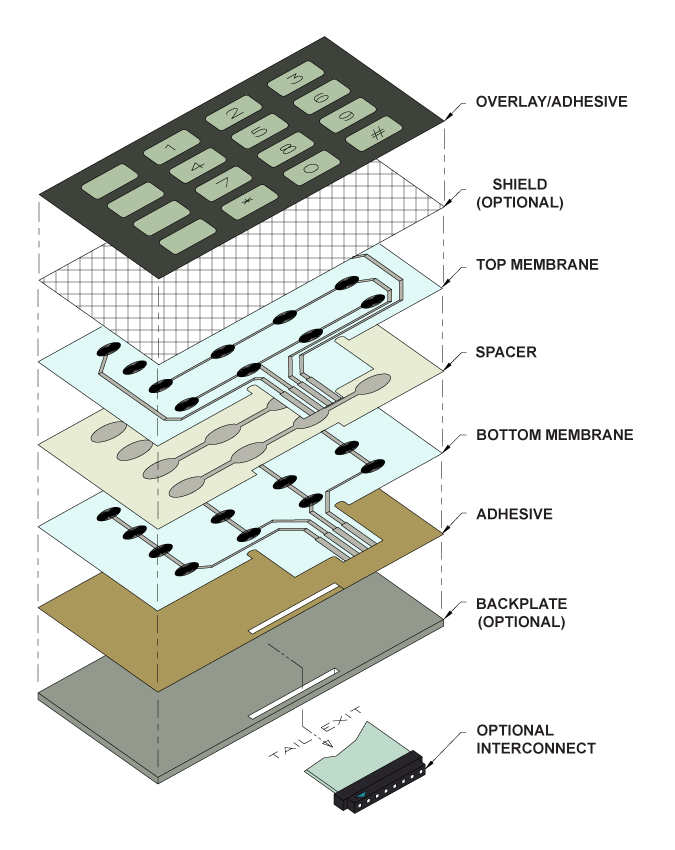The Function of a Membrane Switch in Modern Touch Interfaces and Controls
The Function of a Membrane Switch in Modern Touch Interfaces and Controls
Blog Article
How Membrane Layer Switches Add To the Resilience of Electronic Control Panels
Membrane switches play a critical function in enhancing the sturdiness of electronic control panels, mainly through their multi-layered building which supplies efficient protection versus ecological elements such as moisture and dirt. The absence of relocating components substantially reduces the probability of mechanical failings, making membrane changes suitable for demanding applications.
Definition of Membrane Buttons

Membrane buttons are designed to be thin and light-weight, making them ideal for applications where room is limited. They can be manufactured in different forms, sizes, and shades, providing versatility in style that meets aesthetic and useful requirements. Additionally, membrane buttons can include various technologies, such as tactile feedback and LED signs, enhancing user experience.
Due to their building and construction, membrane layer switches are commonly immune to dust, moisture, and general wear, adding to their toughness in demanding atmospheres. Their smooth layout not just promotes very easy cleansing yet additionally minimizes the threat of mechanical failure, making them a favored option for makers seeking trustworthy interface in their digital control panels.
Defense Versus Environmental Factors
The style of membrane switches inherently supplies a degree of security against various ecological aspects, which is vital for keeping performance in difficult problems - Membrane Switch. These buttons are typically created with layers of versatile products that secure inner parts from dampness, dirt, and pollutants. By encapsulating the circuitry, membrane layer changes minimize the risk of brief circuits and corrosion, which can dramatically impair performance
Furthermore, using durable adhesives and sealants during production enhances their resistance to ecological difficulties. Membrane buttons can endure direct exposure to chemicals and solvents, making them suitable for markets such as food handling and healthcare, where health and tidiness are critical. Their seamless surface area style also avoids the build-up of dust and microorganisms, assisting in simpler cleansing and upkeep.
Temperature changes are an additional ecological issue, and membrane buttons are engineered to work effectively throughout a large range of temperatures (Membrane Switch). This adaptability ensures that control board stay operational in different setups, from commercial environments to customer electronic devices
Influence On Customer Communication
User communication with digital control panels is substantially affected by the design and functionality of membrane layer switches. These switches give a responsive user interface that improves the general customer experience, enabling user-friendly navigating and control. Their responsive nature ensures that users receive prompt responses upon activation, which is essential for jobs calling for accuracy and performance.
In addition, the smooth surface of membrane layer switches promotes very easy cleansing and upkeep, promoting customer confidence in the integrity of the interface. Read Full Report This tidiness is specifically essential in environments where health is critical, such as clinical or food handling setups. In addition, the compact and light-weight design of membrane switches over contributes to the visual charm of control panels, encouraging customer engagement through a contemporary and sleek look.
Furthermore, the integration of visual aspects, such as published symbols and backlighting, assists customers quickly recognize functions, decreasing the finding out curve related to new equipment. Therefore, customers can run tools extra effectively, leading to boosted performance and contentment. In summary, membrane buttons play a critical function in boosting individual communication by integrating capability, aesthetics, and simplicity of usage, eventually bring about boosted operational efficiency.
Style Flexibility and Modification
Design flexibility and modification are necessary facets of membrane buttons, making it possible for makers to customize digital control panels to details applications and customer demands. This adaptability enables the combination of numerous layout aspects, such as colors, graphics, and structures, which can improve the visual allure and user interaction of the control panel.
Membrane switches can be personalized in shapes and size, fitting a vast array of tools and applications, from commercial equipment to customer electronic devices. This adaptability makes sure that makers can create intuitive interfaces that align with individual expectations and functional needs. In addition, the ability to incorporate unique attributes such as backlighting or tactile responses even more boosts use, permitting for a more interactive experience.
Moreover, the manufacturing process for membrane layer changes sustains the fast prototyping of layouts, allowing makers to repeat and improve their ideas quickly. This ability not just increases the development timeline yet likewise guarantees that the final item fulfills particular practical and aesthetic standards.

Cost-Effectiveness and Longevity
Cost-effectiveness and durability are considerable benefits of membrane buttons, making them an eye-catching option for makers and end-users alike. These buttons check my reference are generally more economical to create than traditional mechanical buttons, largely due to their simplified manufacturing procedures and the lowered variety of components required. This price benefit extends not just to initial production but likewise to long-term operational costs, as membrane switches typically call for less upkeep and have a lower failure rate.
Furthermore, the long life of membrane layer switches over contributes to their general worth. Constructed from durable materials, they are immune to ecological elements such as wetness, dust, and chemicals, which can bring about premature see this site wear in various other button kinds. The lack of relocating parts reduces mechanical failure, permitting membrane layer changes to keep capability over prolonged durations.
This toughness is particularly beneficial in applications requiring consistent performance under demanding conditions, such as clinical devices and industrial tools. Eventually, the combination of cost-effectiveness and longevity makes membrane switches a financially feasible option for producers, offering trusted remedies that endure the test of time while optimizing budgetary considerations.
Conclusion
In verdict, membrane buttons dramatically boost the sturdiness of digital control panels via their durable construction and safety attributes - Membrane Switch. On the whole, membrane switches over stand for a dependable and affordable choice for boosting the longevity and functionality of electronic control systems.
Report this page